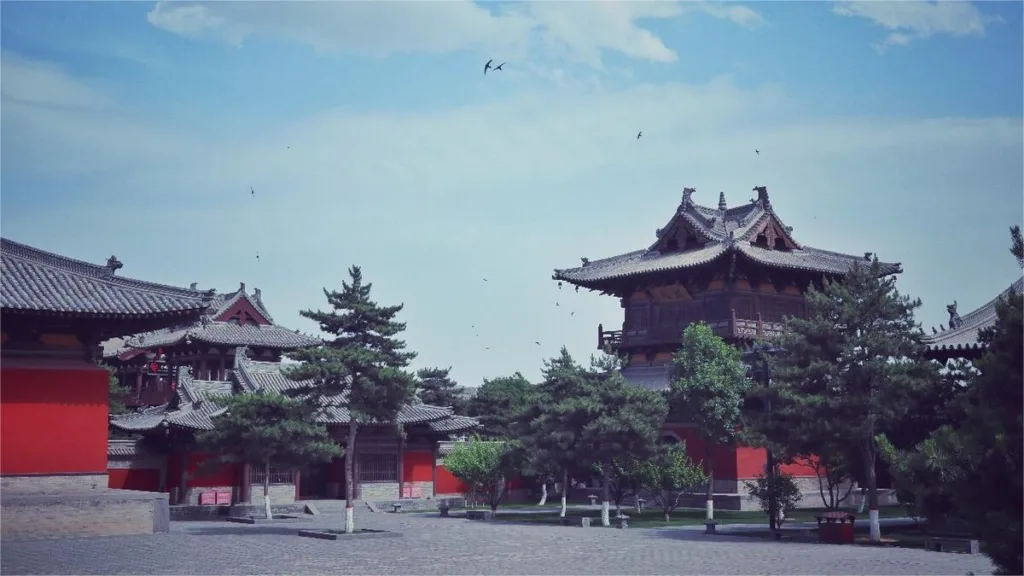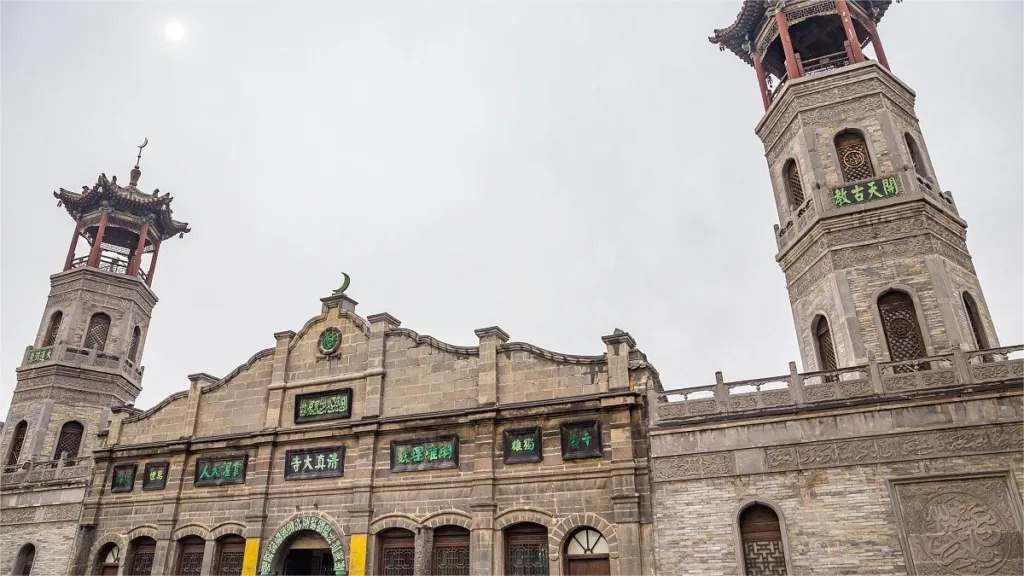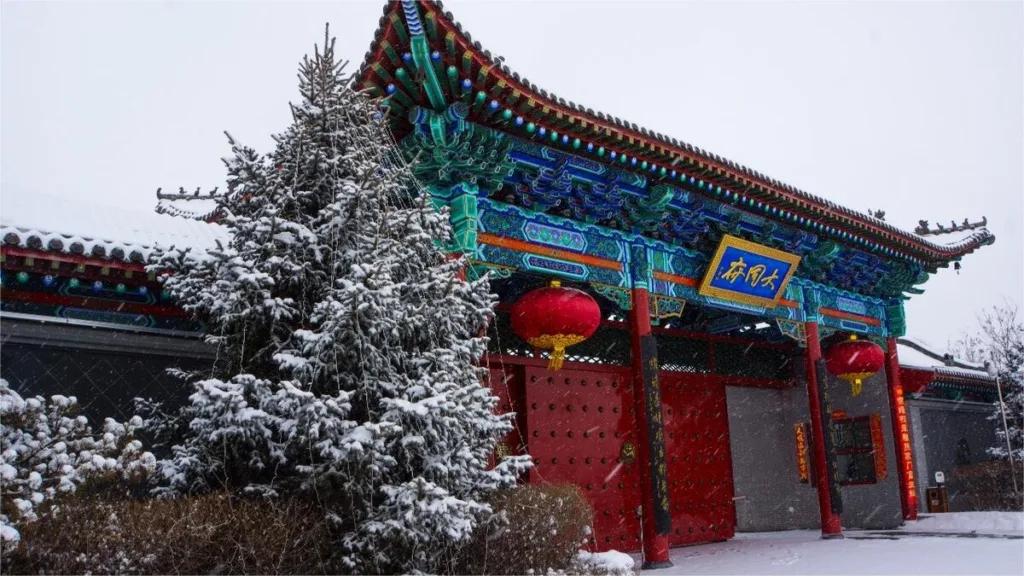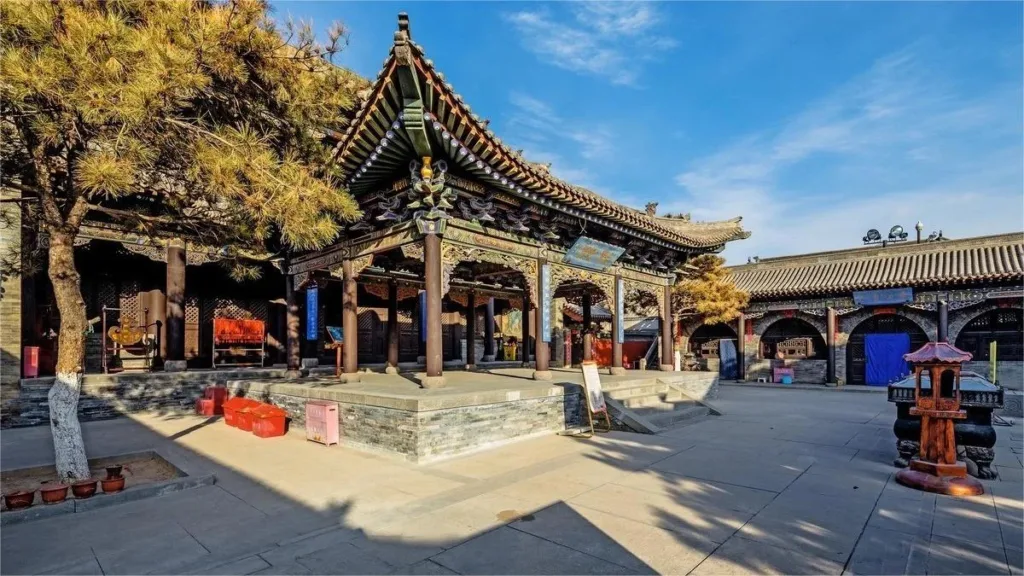Datong Ancient City (大同古城), with its rich and storied history, has long been a significant urban center. As early as the Northern Wei Dynasty, when it served as the capital for the Tuoba clan, the city boasted a grand and extensive fortification. During the early Ming Dynasty, due to its strategic military importance as a defense perimeter for the capital, General Xu Da undertook a major reconstruction of the city in 1372. This development was based on the existing structures from the Northern Wei, Tang, Liao, and Jin dynasties.
The city’s layout is roughly square, with an east-west length of 1.8 kilometers and a north-south length of 1.82 kilometers, encompassing an area of 3.28 square kilometers and a perimeter of 7.24 kilometers. The city walls, built on solid foundations of neatly arranged stone slabs and blocks, were reinforced with rammed earth and clad in blue bricks. These walls reach a height of 14 meters, with a width of 12 meters at the top and 18 meters at the base.
Datong’s fortifications include 54 watchtowers, 96 bunkers, and 580 pairs of battlements, symbolizing the number of villages under Datong’s jurisdiction at that time. Each corner of the city features a corner tower and an additional military platform outside. The city has four gates: Heyang Gate to the east, Yongtai Gate to the south, Qingyuan Gate to the west, and Wuding Gate to the north, each crowned with a gate tower. Between the gate towers, you will find moon towers, arrow towers, and corner towers, all contributing to a well-defended structure. Additionally, wengcheng (barbicans), moon cities, and a protective moat further enhanced the city’s defenses.
In 2008, Datong launched a comprehensive historical and cultural revival and ancient city protection project, leading to the restoration of the ancient city walls. Today, the majestic walls, the sparkling moat, and the scenic belt park complement the city’s ancient temples, churches, pavilions, archways, and traditional courtyard houses. The brilliance of Datong, as the imperial capital of the Northern Wei and a major stronghold during the Ming and Qing dynasties, has been magnificently revived, preserving its legacy as a “majestic stronghold” and the “northern key.”
Table of Contents
- Basic Information
- Location and Transportation
- Map of Datong Ancient Town
- Highlights of Datong Ancient Town
- Other Iconic Attractions in Datong
Basic Information
| Estimated Length of Tour | 1 day |
| Ticket Price | Free |
| Opening Hours | The ancient city is accessible 24 hours a day. Most attractions operate from 8.00 to 18.00 |
| Telephone Number | 0086-0352-7699269 |
Location and Transportation
Datong Ancient City is located in the central part of Pingcheng District, Datong City, Shanxi Province. To get there, you can choose one of the following ways:
To the main gate: Take bus 35 or 61 and get off at Junction of Yongtai South Road and Yingbin Street Stop (永泰南路迎宾街口).
To the central area: Take bus 35 or 38 and get off at Sipailou Stop (四牌楼站).
Map of Datong Ancient Town

Highlights of Datong Ancient Town
Huayan Temple (华严寺)

Huayan Temple, originally built during the Liao Dynasty, faces east in accordance with the Khitan people’s sun-worshipping customs. The oldest existing structure in the temple is the Puguang Pavilion, constructed in the 7th year of Chongxi (1038) and rebuilt in the 8th year of Qingning (1062). In the same year, stone and bronze statues of emperors were enshrined here, giving the temple an imperial ancestral shrine character. The temple suffered damage due to military conflict in the 2nd year of Baoda (1122). The Mahavira Hall was reconstructed in the 3rd year of Jin Tianjuan (1140), underwent repairs during the Yuan Dynasty (1308-1311), and was divided into two sections during the Chenghua and Wanli periods of the Ming Dynasty (1465-1620). Inside the Puguang Pavilion, visitors can see Liao Dynasty murals, colored sculptures, glazed tiles, scripture pillars, stone inscriptions, and Ming and Qing Dynasty wood carvings, colored sculptures, and murals. The Mahavira Hall of Huayan Temple is notable for its grandeur and the towering roof decorations, making it the largest Buddhist temple hall in China.
Shanhua Temple (善化寺)

Shanhua Temple, commonly known as the South Temple, is the most well-preserved Liao and Jin Dynasty temple in China. According to temple inscriptions, it was originally built during the Kaiyuan period of the Tang Dynasty and was later rebuilt by the Jin Dynasty monk Yuanman. In the 10th year of the Zhengtong period (1445) of the Ming Dynasty, Emperor Yingzong bestowed the name Shanhua Temple, which has been used ever since. The Hall of Heavenly Kings (Mountain Gate), Hall of the Three Saints, Mahavira Hall, and Puxian Pavilion are Liao and Jin Dynasty structures, while the side halls and bell and drum towers were built during the Ming and Qing Dynasties. The temple houses 33 Jin Dynasty statues, 190 square meters of Qing Dynasty murals, 9 Ming Dynasty statues, 2 Jin Dynasty stele, and 3 Ming and Qing Dynasty restoration steles.
Great Mosque (清真大寺)

The Great Mosque, also known as Qingzhen Mosque, was established in the 2nd year of the Tang Dynasty’s Zhenguan period (628). It underwent several reconstructions during the Ming and Qing Dynasties, and the current buildings are from the Qing Dynasty. It was designated as a city-level cultural relic protection unit on February 24, 1981, and was listed as a provincial-level cultural relic protection unit in the fifth batch on June 22, 2016.
Kaihua Temple (开化寺)

Kaihua Temple currently functions as the Liao, Jin, and Yuan Nationalities Integration Museum and is one of the nine branches of the Datong City Museum. According to the Daoguang edition of the “Datong Prefecture Annals,” the temple was destroyed during the Jiang Xiang Rebellion and later rebuilt on the original site. The original layout of the temple remains unknown. Today, only the Mahavira Hall remains, a structure from the Ming and Qing dynasties. The hall’s wooden beam structure is well-preserved.
Datong Prefecture Government Office (大同府衙)

The Datong Prefecture Government Office, as recorded in the “Datong Prefecture Annals,” was located in the northwest corner of the city. It was constructed in the 9th year of the Hongwu period (1376) by Chen Ze and expanded by Prefect Wang Chengjue. This complex of buildings was one of significant scale. In the 5th year of the Shunzhi period (1648) of the Qing Dynasty, it was destroyed during the Jiang Xiang Rebellion. It was rebuilt in the 6th year of the Shunzhi period (1649) by Prefect Hu Yeding. Currently, only the second hall and the rear hall remain.
Xuanzhen Taoist Temple (玄真观)

Xuanzhen Taoist Temple is located on Zhengdian Street, at the site of the old Guangzhi Gate of the Prince Dai’s Mansion. The building’s foundation dates back to the Hongwu period (1368-1398) of the Ming Dynasty, with additional structures built during the Shunzhi period of the Qing Dynasty. The surviving foundation is an early Ming Dynasty structure, over 600 years old. The main hall on this foundation is from the Qing Dynasty.
Nine-Dragon Wall (九龙壁)

The Nine-Dragon Wall, originally the screen wall of the mansion of Prince Zhu Gui of the Ming Dynasty, is the oldest, largest, and best-preserved dragon wall in China.
Guandi Temple (关帝庙)

Commonly known as the Great Temple, the exact date of Guandi Temple‘s founding is unknown. The existing main hall is a Yuan Dynasty structure. According to the “Datong Prefecture Annals,” the temple underwent several reconstructions during the Ming Dynasty and further expansions during the Kangxi (1662–1722) and Qianlong (1736–1795) periods of the Qing Dynasty. On January 12, 1996, it was designated a provincial-level cultural relic protection unit. The temple’s theater stage, initially built during the Shunzhi period of the Qing Dynasty, was originally located opposite the Nine-Dragon Wall of the Prince Dai’s Mansion and later moved to the front of Guandi Temple. It is a fine example of Ming and Qing architectural styles.
Museum of Ancient Copper Art (古代铜造艺术博物馆)

As one of the nine branches of the Datong City Museum, the Museum of Ancient Copper Art opened to the public on December 21, 2019. Its main exhibit, “Copper Brilliance in Datong – Ming and Qing Copper Art,” is divided into four sections: “Ancient Charm and New Style,” “Perfect Craftsmanship,” “Leisurely Enjoyment,” and “Luxurious Copper.” The exhibit showcases 247 artifacts, including Ming and Qing Dynasty imitations of Shang and Zhou Dynasty bronze ritual vessels, Xuande furnaces, literary appreciation items, and artifacts reflecting Mongolian-Han commercial exchanges. These pieces illustrate the prosperity, cultural richness, and ethnic integration of Datong during the Ming and Qing periods.
Datong Ancient City Wall (大同古城墙)

The current city wall of Datong was reconstructed in 1372 during the 5th year of the Hongwu period by General Xu Da of the Ming Dynasty, based on the foundations of the old city walls from the Han, Wei, Tang, Liao, Jin, and Yuan dynasties. On June 22, 2016, it was listed as a provincial-level cultural relic protection unit. Near the city wall, there is a specialized exhibition hall dedicated to the wall, providing invaluable material for the study of ancient city defense facilities and construction techniques.






Datong, the capital of the Northern Wei Dynasty, was previously known as Xijing. The sense of history here is profoundly rich, and you can feel it the moment you enter the ancient city of Datong. This place is on a completely different level compared to many “fake” ancient towns. Almost everything in the ancient city is free to visit, except for Huayan Temple and the Daiwang Mansion. Traveling during off-peak times, it feels like I’ve claimed countless temples and museums… Read more »
Yesterday, I took an early train to Datong on the high-speed rail. In the morning, I braved the wind and sand to visit Yanhua Temple, and in the afternoon, I faced strong winds at the Yungang Grottoes. Although it was very cold, it was worth the trip! Today, the strong winds continued, and all the attractions in the ancient city were closed. In the afternoon, I adjusted my itinerary and went to the Datong Museum, which I am very excited… Read more »
The night view of the Ancient City of Datong is truly beautiful! I couldn’t stop taking pictures.
When you visit Datong, you absolutely must stay in the ancient city! During the day, explore the nearby attractions, and at night, stroll around to enjoy the beautiful night scenery. It’s just so incredibly gorgeous!
The Datong Ancient City currently has a lantern festival, and you can only enter through the South Gate. On the way inside, you will notice a fascinating phenomenon: there are actually more security guards than tourists. It seems that the peak season will be during the New Year when more visitors come to see the lanterns.
Walking along the city river and through the park, we entered the Ancient City of Datong. The bustling commercial atmosphere inside the ancient city is similar to other places, but what sets it apart is the presence of numerous temples. We headed straight to Huayan Temple, and the ancient, solid, and tidy temple immediately calmed and quieted us. When we arrived at the Mahavira Hall, we couldn’t help but marvel at its grandeur—how many years of history must this have… Read more »
The Datong City Wall is especially perfect for a stroll in the evening. It stretches about 7.2 kilometers and stands 14 meters high. Recently, there has also been a lantern festival in the evenings.